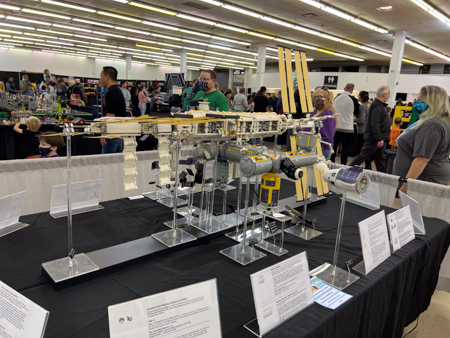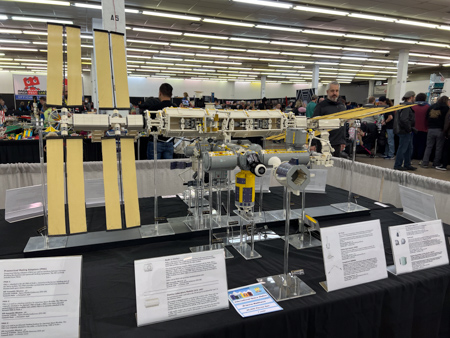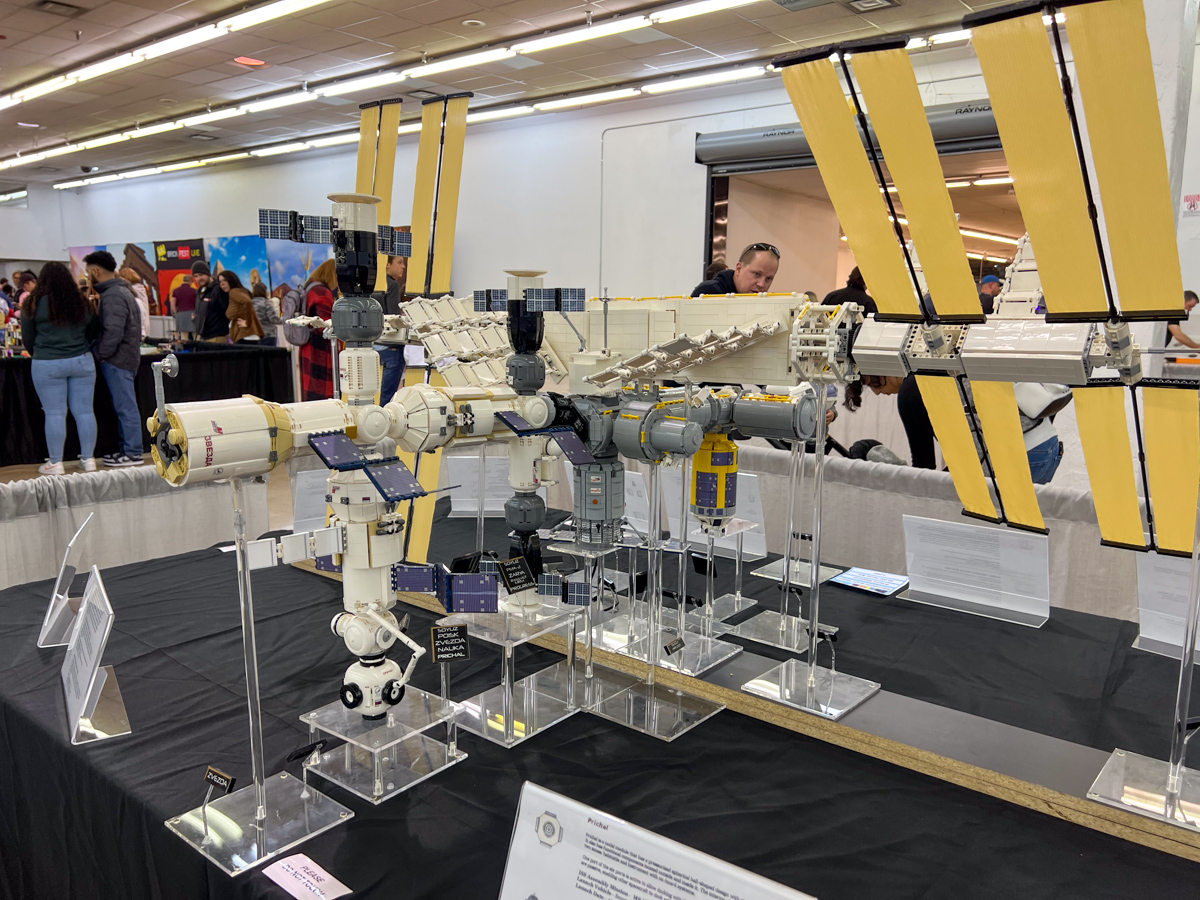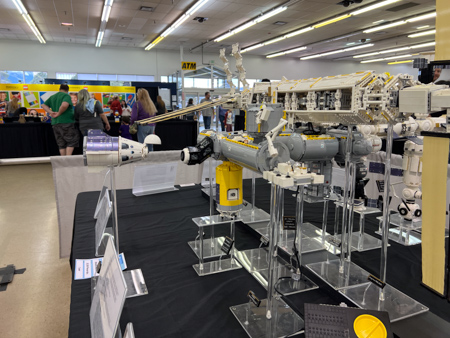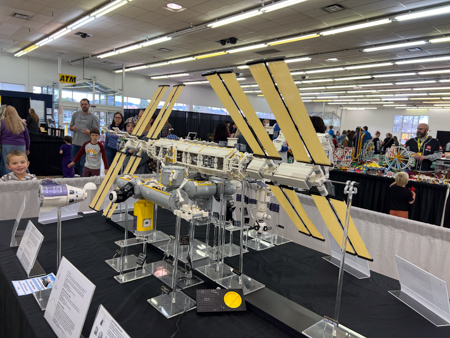Along with the model itself, Brianna put together informational cards to display alongside the model.
Node 1 (Unity)
Node 1, also known as Unity, was the first American built pressurized module added to the station. The module has six Common Berthing Mechanisms (CBM). Each CBM provides a mounting point for other modules.
Two Pressurized Mating Adapters (PMA) were launched with the Node. PMA-1, attached to the aft CBM, serves as a pressurized tunnel between the Zarya module and Node 1. PMA-2, used as a docking port for American Space Shuttles, was originally attached to the forward CBM. PMA-2 has been relocated several times as new modules were added. PMA-2 is currently attached to the forward CBM on Node 2.
Node 1 can be fitted with up to four standard payload racks.
ISS Assembly Mission – 2A
Launch Vehicle – Space Shuttle Endeavour (STS-88)
Launch Date – 4 December 1998
Pressurized Mating Adapters (PMA)
Pressurized Mating Adapters (PMA) are used as interfaces between Common Berthing Mechanisms and spacecraft docking equipment. The ISS currently includes three PMAs.
PMA-1
PMA-1, attached to the aft CBM of Node 1, connects to the forward docking port of the Zarva module. The PMA provides a pressurized tunnel between American and Russian built space station sections.
ISS Assembly Mission – 2A
Launch Vehicle – Space Shuttle Endeavour (STS-88)
Launch Date – 1 December 1998
PMA-2
PMA-2 is used as a docking interface for American Space Shuttles. The PMA was originally attached to the forward CBM of Node 1. PMA-2 has been relocated several times as new modules were added. PMA-2 is currently attached to the forward CBM on Node 2.
ISS Assembly Mission – 2A
Launch Vehicle – Space Shuttle Endeavour (STS-88)
Launch Date – 4 December 1998
PMA-3
PMA-3 is used as an alternate docking location for American Space Shuttles. The PMA was originally attached to the nadir, or Earth facing, CBM of Node 1.
ISS Assembly Mission – 3A
Launch Vehicle – Space Shuttle Discovery (STS-92)
Launch Date – 11 October 2000
Z1-Truss
The Z-1 Truss houses communications, electrical distribution, and attitude control equipment. Z-1 is permanently attached to the Zenith berthing port on Node 1.
Communication equipment includes components for both S-band and Ku-band systems. Four control moment gyroscopes (CMG) provide attitude control for the station.
ISS Assembly Mission – 3A
Launch Vehicle – Space Shuttle Discovery (STS-92)
Launch Date – 11 October 2000
Destiny Laboratory Module (U.S. Lab)
Located between Node 1 and Node 2, the US Lab can be considered the “core” of the American section.
The module is designed to hold 24 standard size modular racks. These racks can be changed out in orbit and can be used for different purposes, including life support equipment, robotics control stations, crew quarters, waste management, storage, and various scientific experiments designed to be installed in orbit. New payload racks can be delivered in an MPLM, or the Japanese HTV spacecraft.
A high quality window, 50.9 cm (20 inch) in diameter, is located in the side of the module. This window can be used for photography and other Earth resource experiments.
H-II Transfer Vehicle (HTV)
The H-II Transfer Vehicle (HTV) was developed by the Japan Aerospace Exploration Agency (JAXA). Each HTV is launched on an H-IIB rocket. The first HTV mission occurred in 2009.
The HTV measures approximately 10 meters by 4.4 meters and can transport a payload of around 6 tons, including both internal and external cargo. Internal cargo is housed in a pressurized volume designed to hold up to eight International Standard Payload Racks (ISPRs). An unpressurized section allows external cargo to be transported. A removable pallet, supporting external cargo, can be extracted from the side of the HTV using Canadarm 2. The pallet can be temporarily attached to the ISS, allowing external cargo to be unloaded as needed.
Columbus Laboratory
The Columbus Laboratory was designed and built by the European Space Agency. The module provides pressurized laboratory space and can accommodate up to ten standard payload racks. The module has four mounting points for external experiments.
Columbus is attached to the starboard port of Node 2.
ISS Assembly Mission – 1J/A
Launch Vehicle – Space Shuttle Atlantis (STS-122)
Launch Date – 7 February 2008
Soyuz
Originally part of the Soviet Moon landing program, Soyuz has evolved into one of the world’s most reliable crew transport spacecraft.
The value of Soyuz goes far beyond simply carrying crew to and from space. Soyuz, capable of spending six months docked to a station, can serve as a lifeboat, allowing a space station to be evacuated at any time if conditions require it. Progress supply ships, based on Soyuz technology, can supply orbiting stations with fuel, water, food, spare parts, and other critical items.
Without Soyuz and Progress, continuous crewing of orbital outposts would not be possible.
Zvezda Service Module
Similar to the Mir base block, Zvezda provides living quarters, waste management equipment, life support systems, communications and control equipment. The module has four docking ports.
Zvezda includes a propulsion system consisting of 32 attitude control engines and two orbital maneuvering engines.
ISS Assembly Mission – 1R
Launch Vehicle – Proton
Launch Date – 12 July 2000
Nauka Multipurpose Laboratory Module (MLM)
Successfully launched on a Proton rocket on July 21, 2021, the Nauka Multi-purpose Laboratory Module, MLM, docked to the International Space Station, ISS, eight days later, giving the outpost a plethora of new capabilities and resuming the assembly of the station’s Russian Segment after a decade-long hiatus. In development for nearly a quarter of a century, the 20-ton Nauka became Russia’s largest spacecraft to enter orbit since the launch of the Zvezda Service Module to the ISS in 2000.
ISS Assembly Mission – 6R
Launch Vehicle – Proton rocket
Launch Date – 21 July 2021
Prichal
Prichal is a nodal module that has a pressurized spherical ball-shaped design with six hybrid docking ports. It also has functional components located outside and inside it. The interior of the module is divided into two zones: habitable and instrument with on-board systems.
One port of the six ports is active to allow docking with the space station, while the remaining five ports are passive, enabling other spacecraft to dock with the module.
ISS Assembly Mission – MS 17
Launch Vehicle – Soyuz/Progress
Launch Date – 14 November 2021
Zarya Control Module
The Zarya module, sometimes known as the Functional Cargo Block (FGB), was the first ISS module to be launched. Paid for by the United States, Zarya was built by Russia. The module provided power, attitude control, and other systems for the station during early years of construction. The module continues to provide storage space for space station supplies.
ISS Assembly Mission – 1 A/R
Launch Vehicle – Proton rocket
Launch Date – 20 November 1998
Permanent Multipurpose Module (PMM)
The Permanent Multipurpose Module was created by modifying a Multi-Purpose
Logistics Module (MPLM). MPLMs were originally constructed to transfer pressurized cargo to and from the space station. Designed to be transported in the space shuttle cargo bay, these modules were only designed for several weeks in space. The MPLM “Leonardo” was transformed into the PLM. Modifications included increased micrometeoroid shielding, and internal changes to increase accessibility of equipment for maintenance in orbit.
The PMM is berthed to the nadir port of Node 1.
ISS Assembly Mission – ULF5
Launch Vehicle – Space Shuttle Discovery (STS-133)
Launch Date – 24 February 2011
Joint Airlock (Quest)
The Quest airlock supports Extravehicular Activity (EVA). Quest is composed of two cylindrical chambers. The larger chamber, known as the Equipment Lock, provides an area for storing and maintaining EVA equipment, and for conducting EVA preparations. The smaller chamber, known as the Crew Lock, can be depressurized to allow astronauts to exit the module. To reduce the amount of atmosphere lost during each EVA depressurization, a special pump is used to extract as much atmosphere as possible from the Crew Lock prior to venting the remaining atmosphere.
ISS Assembly Mission – 7A
Launch Vehicle – Space Shuttle Atlantis (STS-104)
Launch Date – 12 July 2001
Mobile Base System (MBS)
The Mobile Base System (MBS) serves as a base for Canadarm2 and Dextre. The MBS is mounted on a mobile transporter that can move along a track mounted on the main truss.
ISS Assembly Mission – UF-2
Launch Vehicle – Space Shuttle Endeavour (STS-111)
Launch Date – 5 June 2002
Canadarm2 (SSRMS)
Canadarm2, also known as the Space Station Remote Manipulator System (SSMRS) is a 17.6 meter robotic arm used to assemble and service the International Space Station. The arm has seven degrees of freedom and features Latching End Effectors (LEEs) at each end. The LEEs can attach to payload grapple fixtures or to Power Data Grapple Fixtures (PDGFs) located at strategic points around the station. The PDGFs serve as mounting points for the arm and permit power and data connections to be made. The arm can reposition itself from one PDGF location to another using an inchworm-like movement.
ISS Assembly Mission – 6A
Launch Vehicle – Space Shuttle Endeavour (STS-100)
Launch Date – 19 April 2001
Crew Dragon Spacecraft
Crew Dragon was developed as part of NASA’s Commercial Crew Development (CCDev) program and is used to transport astronauts to the International Space Station.
An orbital test flight, including docking at the ISS, was successfully completed in March 2019. The first crewed mission to the ISS, SpX-DM2, was launched in May 2020.
Nanoracks
NASA accepted a proposal from NanoRacks to send the first commercial airlock to the International Space Station (ISS) in 2019. This milestone is only the latest of many that has seen the orbiting laboratory gain increased commercial use.
Houston-based NanoRacks has been sending small satellites to be deployed out of the Japanese Kibo airlock for seven years now. The airlock, however, is only big enough to send out things that are about the combined size of a small refrigerator. Additionally, the airlock is only opened about 10 times each year with only five of those allocated to NASA and commercial partners. The other five go to the Japan Aerospace Exploration Agency (JAXA), which owns the airlock.
ISS Assembly Mission – CRS-21
Launch Vehicle – SpaceX Dragon spacecraft
Launch Date – 6 December 2000
Bigelow Expandable Activity Module (BEAM)
The Bigelow Expandable Activity Module (BEAM) is an experimental expandable space station module developed by Bigelow Aerospace, under contract to NASA, for testing as a temporary module on the International Space Station (ISS) from 2016 to at most 2028.
The BEAM is an experimental program in an effort to test and validate expandable habitat technology. If BEAM performs favorably, it could lead to development of expandable
habitation structures for future crews traveling in deep space.
ISS Assembly Mission – CRS-8
Launch Vehicle – SpaceX Dragon spacecraft
Launch Date -10 April 2016
Kibo Pressurized Module (PM)
The Kibo pressurized module measures 4.4m in diameter, and 11.2m in length. The module includes two large windows, a robotic arm, and a scientific airlock. A common berthing adaptor, on the zenith surface, provides an attachment point for the ELM-PS.
ISS Assembly Mission – 1J
Launch Vehicle – Space Shuttle Discovery (STS-124)
Launch Date – 31 May 2008
Kibo Exposed Facility (EF)
The Kibo Exposed Facility is an external platform that provides attachment points for various experiments and components. Kibo’s robotic arm can be used to service these experiments. If necessary, individual components may be brought into the pressurized module using the airlock.
ISS Assembly Mission – 2J/A
Launch Vehicle – Space Shuttle Endeavour (STS-127)
Launch Date – 15 July 2009
Kibo Experiment Logistics Module – Pressurized Section (ELM-PS)
The Experiment Logistics Module provides storage space for the Kibo laboratory. The first module to be launched, the ELM-PS was temporarily berthed to node 2’s zenith port. After the launch and berthing of the Kibo Pressurized Module, the ELM-PS was moved to its permanent location.
ISS Assembly Mission – 1J/A
Launch Vehicle – Space Shuttle Endeavour (STS-123)
Launch Date – 11 March 2008
Node 2 (Harmony)
The Node 2 module includes six CBM ports and can be fitted with up to eight standard payload racks. The module is attached to the forward CBM of the Destiny laboratory module.
Pressurized Mating Adaptor-2 (PMA-2), relocated from the forward CBM of the Destiny laboratory module, is attached to the forward CBM of Node 2 and serves as the primary docking port for American space shuttles. The Japanese Kibo laboratory connects to the port CBM, while the starboard CBM is occupied by the European Columbus laboratory module.
As originally planned, the Centrifuge Accommodation Module was to have berthed at the zenith CBM. The Centrifuge Accommodation Module has been cancelled and will not be part of the finished ISS design.
Node 2 was constructed by Thales Alenia Space in Italy.
ISS Assembly Mission – 10A
Launch Vehicle – Space Shuttle Discovery (STS-120)
Launch Date – 23 October 2007
Node 3 (Tranquility)
The Node 3 module includes six CBM ports and can be fitted with up to eight standard payload racks. The module is currently attached to the port berthing port on Node 1.
Node 3 was designed and built by Thales Alenia Space in Italy.
ISS Assembly Mission – 20A
Launch Vehicle – Space Shuttle Endeavour (STS-130)
Launch Date – 8 February 2010

Cupola
The Cupola allows panoramic views of space and provides a robotics control station for operating Canadarm 2 and Dextre.
The Cupola features seven large windows. Each window has four panes, an inner pane to protect from scratches, two pressure pains, each 25mm thick, and an outer pane to protect from space debris. Each window pane can be replaced if needed. To reduce damage from micrometeoroids and orbital debris, the windows are covered with moveable shutters when not in use.
The Cupola is currently attached to the Earth-facing berthing port on Node 3.
ISS Assembly Mission – 20A
Launch Vehicle – Space Shuttle Endeavour (STS-130)
Launch Date – 8 February 2010
Cygnus Spacecraft
Developed by Orbital Sciences Corporation, in partnership with NASA, Cygnus was designed to ferry pressurized cargo to the International Space Station. Known as CRS, or commercial resupply missions, these flights are scheduled to occur around twice per year. At the end of each mission, the spacecraft performs a destructive re-entry into the atmosphere.
Antares Rocket
Developed by Orbital Sciences Corporation, the Antares rocket is designed to launch over 5,000 kg into low Earth orbit.
Progress Supply Ship
Limited duration space stations, such as Skylab and several of the early Salyut stations, were launched with all the supplies needed for their planned missions. Stations designed for longer occupation often can not be launched with all supplies on board. Things such as food, water, fuel, spare parts and other items are needed to maintain the station. While crewed spacecraft, such as Soyuz, can carry a limited amount of cargo in addition to crew, it is not nearly enough to support ongoing operations.
Mini Research Module-1 (MRM-1)
The Russian built Mini Research Module-1 (MRM-1) provided the station with additional storage space, as well as additional clearance for Soyuz docking approaches. The MLM is berthed at the Nadir (Earth facing) port of the Zarya (FGB) module.
MRM-1 was launched with Russian and American supplies loaded inside.
ISS Assembly Mission – ULF4
Launch Vehicle – Space Shuttle Atlantis (STS-132)
Launch Date – 14 May 2010
Docking Compartment 1 (Pirs)
Progress M-SO1, launched on a Soyuz rocket on 14 September 2001, delivered the Pirs module to the ISS. Pirs will serve as an airlock for EVAs using Russian space suits. The Pirs module also provides a docking port for Soyuz or Progress spacecraft.
ISS Assembly Mission – 4R
Launch Vehicle – Soyuz / Progress
Launch Date – 14 September 2001

